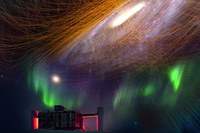Our Exotic Universe
To mark its tenth anniversary, the Ruhr Astroparticle and Plasma Physics Center is treating astronomy fans to something special: Celebrations will include a new, impressive show at the Bochum Planetarium.
Plasma, particle, and astrophysics – at first glance, these terms may sound abstract. However, the new planetarium show “Our Exotic Universe” proves that the results of these research disciplines can be visually stunning. Researchers from the Ruhr Astroparticle and Plasma Physics (RAPP) Center developed and implemented the show together with the team at the Bochum Planetarium. It has been finalized right on time to celebrate RAPP Center’s tenth anniversary. The show will run for the public at the Bochum Planetarium from October 12, 2025, bringing current research on the universe to a wide audience. Starting January 2026, the show will be played in different cities across Germany in German language. An English version will be featured abroad from February 2026.
“We are very pleased to be able to present our work in this way and make it accessible to a wide audience,” says Professor Julia Tjus from the Ruhr University Bochum, director of the RAPP Center. The center is a collaboration between the three universities in the Ruhr region – Bochum, Dortmund, and Duisburg-Essen – and partners from the University of Wuppertal.
Journey to extreme places
In the new show, visitors embark on a fascinating journey of discovery to the extreme places of the Universe. They find themselves in the midst of the remnant of a star explosion, see galaxies glowing in radio light, and experience how an entire star is torn apart at the edge of a massive black hole. It becomes clear that the big things in the Universe are often connected to the smallest things, which are often the key to understanding strange objects in space. The show dates can be found on the Bochum Planetarium website (https://www.planetarium-bochum.de/de_DE/program/unser-exotisches-universum.1383744#/).
The production was made possible with funding from the German Research Foundation (Deutsche Forschungsgemeinschaft). The research shown in the show is part of the Collaborative Research Center 1491 “Cosmic Interacting Matter – From Source to Signal” – one of the central collaborative research projects of the RAPP Center. “From students to doctoral candidates and postdocs to professors, an incredible number of people contributed to the show,” Julia Tjus emphasizes. “Many of the images shown were taken by the researchers themselves, for example with telescopes in Antarctica, on La Palma, or at CERN.”
“Working together with scientists to develop a show is a unique experience. Together, we were able to bring wonderful images into the dome that immediately transport viewers on a research journey,” says Susanne Hüttemeister, director of the Bochum Planetarium and professor at Ruhr University Bochum.
Cooperation at the RAPP Center
RAPP scientists are researching topics such as the origin of cosmic rays, how magnetic fields are created in the Universe, and the nature of dark matter and neutrino particles. In the future, the center plans to establish new research priorities in the field of artificial intelligence and will broaden its research to plasmas in which collisions between particles are important. These plasmas play a major role in astrophysics in certain locations, such as near the Sun and in molecular clouds, and can also be studied in the laboratory. The universities in Bochum, Dortmund, and Duisburg-Essen, which have been cooperating in the University Alliance Ruhr since 2007, will collaborate even more closely in this area in the upcoming years.
More Information:
RAPP-Center
Collaborative Research Center 1491
https://www.sfb1491.ruhr-uni-bochum.de/
University Alliance Ruhr
Planetarium Bochum




